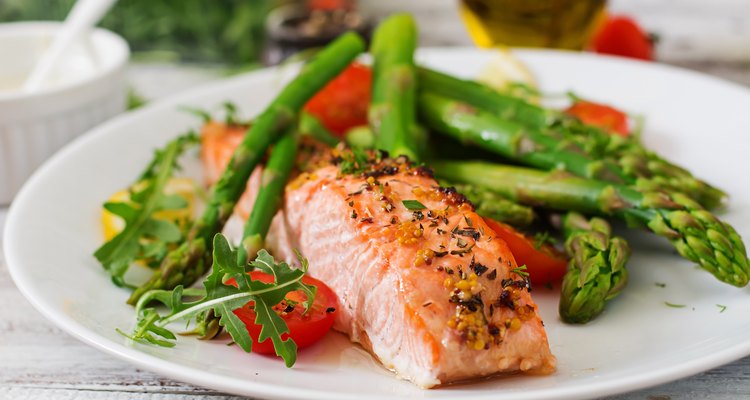
Elena_Danileiko/iStock/GettyImages
The unsaturated fat and high moisture content in salmon's flesh make it a delicious, nutritious fish. Having such good starting material makes it easier on you, the cook. Your number one priority in protecting the quality of the fish is not cooking it too long, since that dries it out. Preparing the salmon in the oven is easier than cooking it on the stove top or grill. Cooking it at low temperature with moist heat helps it remain succulent and tender.
Select fresh salmon with a mild smell, clear and slightly bulging eyes, shiny flesh and bright red gills and no discoloration or dry edges if you're not buying frozen. Fresh fish should never smell too fishy, sour or like ammonia. If buying frozen, avoid torn or otherwise damaged packages and fish showing signs of frosting or freezer burn.
Move frozen salmon into the refrigerator the day before you're going to cook it so it defrosts. If you aren't prepared ahead of time, thaw the salmon by immersing it in a bowl of cold water, provided it's sealed in a leak-proof package. This method only takes about an hour or two. Every 30 minutes, empty the bowl and refill it with colder water. If you don't even have this much time, turn to the defrost function of your microwave.
Put a rack on the lowest tier of your oven and place another just below center so the salmon is in the middle of the oven when it cooks. Preheat to 250 degrees Fahrenheit, starting at least 20 minutes before you put in the salmon.
Fill a cake tin, baking dish or other oven-safe vessel about halfway with water, stock, broth or white wine. Place it on the bottom rack of the oven when you turn it on. The steam will help keep your salmon tender during baking.
Wash away any scales by holding the salmon under cold faucet water. Dry thoroughly with clean paper towels.
Place a wire rack on a baking sheet. Grease the rack with nonstick spray or cooking oil.
Coat the salmon with cooking oil or melted unsalted butter using a brush. Apply salt and pepper to taste, along with any other desired herbs or spices. Add texture, if you like, by selecting sea salt or coarse kosher salt rather than table salt and coarsely ground pepper.
Put the salmon on the wire rack, which elevates the fish to allow hot air and steam to circulate all the way around it. Put it onto the oven tier right below center.
Bake the salmon for about 25 minutes. Cooking time varies, however, based on the thickness of your cut of salmon, the consistency and accuracy of your oven temperature and other considerations. To determine if the fish is fully cooked, cut into the center of the fillet or steak with a fork. The flesh should flake without resistance, and it should look opaque all the way through. Fish doesn't need to rest like meat, so serve it right away.
Related Articles
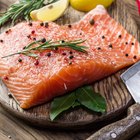
How to Cook Salmon to Moist & Tender ...
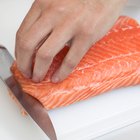
How Long Does It Take for Salmon to ...
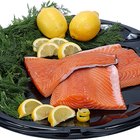
Baking Partially Frozen Salmon

How to Cook Frozen Salmon Fillets ...

Can You Cook Frozen Salmon Whole?

How to Cook Grouper in the Oven
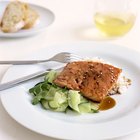
How to Cook Salmon in Pineapple Juice
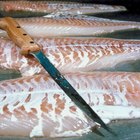
How to Grill a Cod Fish

How to Freeze Catfish
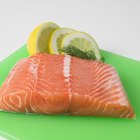
How to Marinate and Pan-Sear Salmon

How to Cook Rockfish in the Oven
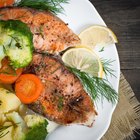
How to Cook a Salmon Steak in the Oven

How to Bake a Frozen Halibut Fillet

How to Bake Lingcod
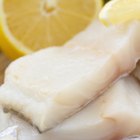
How Long Can Halibut Be Kept Frozen?
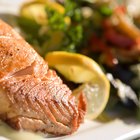
Do I Have to Thaw Out Salmon Before I ...
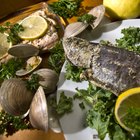
Fish Cooking Temperature
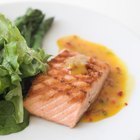
Ways to Cook Salmon Without Butter
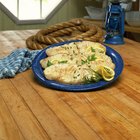
How to Prepare Fabulous Baked Halibut
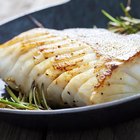
How Do I Pan Fry Fresh Fish With a ...
References
Resources
Tips
- A layer of chopped herbs and other seasonings, such as parsley, dill, basil, garlic and lemon zest, on top of the salmon helps protect its exterior from the heat and imparts a good deal of flavor.
- If you're using fresh or frozen seafood within two days of purchase, put it in an ice bath or in the refrigerator promptly when you get home. Otherwise, store it in airtight packaging in the freezer.
Warnings
- Between 40 F and 140 F is considered the "danger zone" for meat, poultry, fish and other foods. Never leave fish out at room temperature for more than two hours; if you're outside and the temperature is 90 F or higher, don't leave it out for more than one hour.
- Raw seafood contaminates every surface it touches. Wash your hands with soap and water after handling the uncooked salmon. Sanitize all knives, cutting boards, dishes and other kitchen tools and surfaces with which the raw salmon comes into contact.
Writer Bio
Eric Mohrman is a food and drink, travel, and lifestyle writer living in Orlando, Florida. He has professional experience to complement his love of cooking and eating, having worked for 10 years both front- and back-of-house in casual and fine dining restaurants. He has written print and web pieces on food and drink topics for Visit Florida, Orlando Style Magazine, CrushBrew Magazine, Agent Magazine, Dollar Stretcher Magazine, The 863 Magazine and other publications.